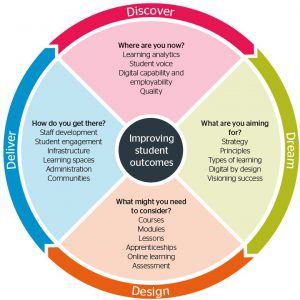Launched on 26th January, Designing learning and assessment in a digital age marks a milestone moment in learning design by capturing the most significant outputs from the last decade of research and development in technology-enhanced practice and combining these with up-to-date exemplars, resources for downloading and adaptation, plus links to sources of further information.
Appreciative inquiry lies at the heart of the guide’s approach. Guidance, expert testimony, case studies and opportunities to ‘get involved’ are clustered under four headings echoing the classic 4 D’s of appreciative inquiry:
- Discover
- Dream
- Design
- Deliver
So what follows in the guide is not about throwing aside what you already do well but engaging in an iterative process of enhancing your design practices, ensuring that you are taking full advantage of digital approaches at every stage in the creative process.
See below our model of the appreciative approach to learning design which also introduces the guide’s structure:
How will the guide make a difference?
Designing learning and assessment in a digital age provides easy access to ‘need-to-know’ information about the processes and initiatives you will need when designing or redesigning learning and assessment for your students.
No need then to chase around for those key resources and evidence of the impact of digital learning on the student experience! This comprehensive resource puts at your disposal the best exemplars and most salient supporting materials to help you in your decision making. In each section, you will also find ways of moving forward.
What our research told us
We conducted a series of in-depth interviews with staff in colleges and universities to pinpoint how digital tools are making a difference to the art of learning design in higher education and further education and skills, and have distilled these messages into the guide. These are some of the key points you made:
- Obtaining students’ views on use of and feelings about technology in learning and assessment should be seen as a vital part of any design process
- ‘Thinking digital’ is not just about putting paper resources on screen. Look for opportunities to develop learner-centred approaches, a more fluid, responsive curriculum – such as learning activities that allow for different outcomes – and teaching that is adaptive to student needs
- An increasing number of studies show retention and other measures of student success can be positively influenced by the use of learning analytics.
- What has proved particularly valuable in all parts of the sector is the card and storyboard approach originally pioneered by our Viewpoints project at Ulster University and adapted many times. This approach to designing whole programmes and modules allows teams to play with (i.e. visualise, undo and remake) a design until all the elements work effectively together
- Learning design is a markedly social and collaborative activity, best undertaken in face-to-face groups which ideally involve students, teaching and support staff
What next?
To keep informed of future developments and events related to learning design, join the Learning Design Cross Institutional Network @ LEARNINGDESIGN@JISCMAIL.AC.UK and follow https://sites.google.com/site/learningdesignsig/home
Workshops
We are piloting a new data-informed approach to the design of blended learning and are running a workshop, on 20th March in Birmingham, to test the concept. If you are interested in participating in order to give us feedback and help develop the approach you can find out more here.
Feedback
Please bookmark the new guide: https://ji.sc/design-learn-assess
We welcome your feedback on the guide to inform future iterations. Please email any comments to Sarah.knight@jisc.ac.uk

